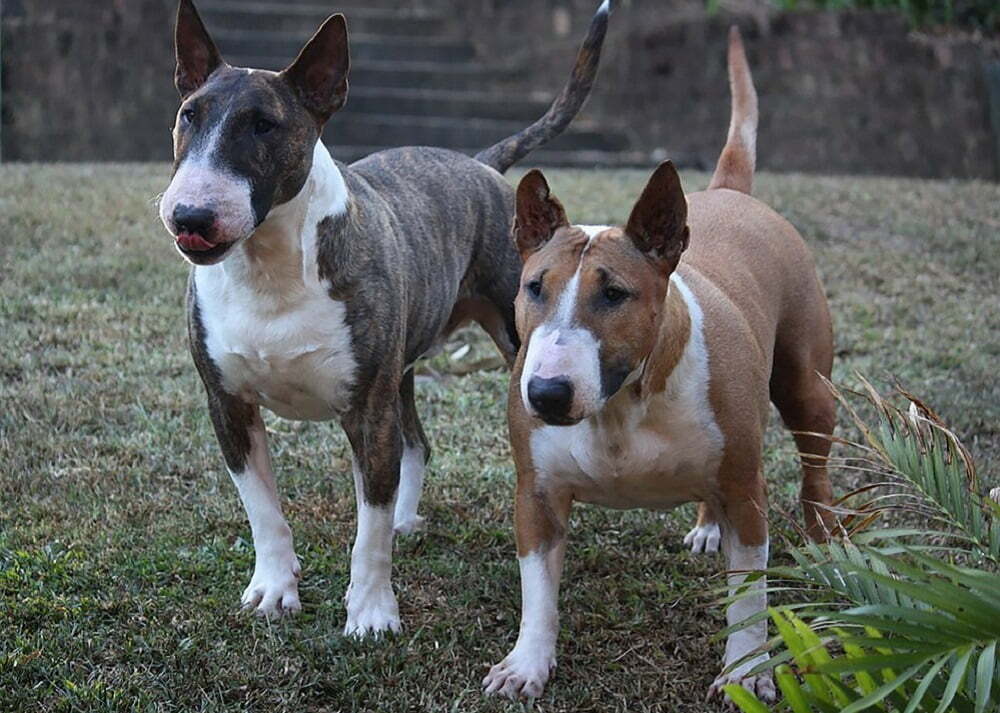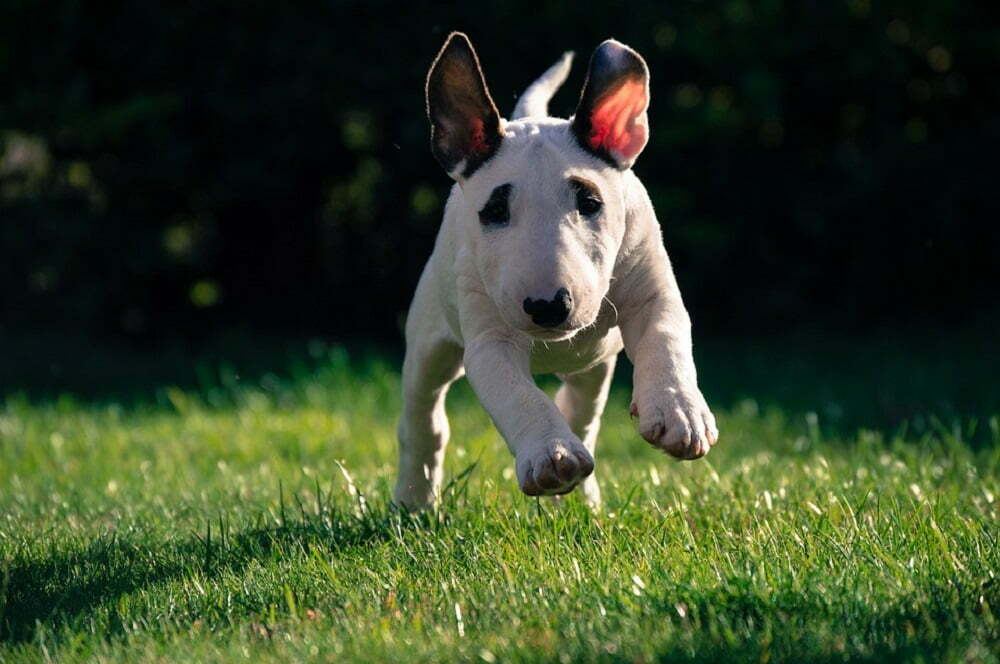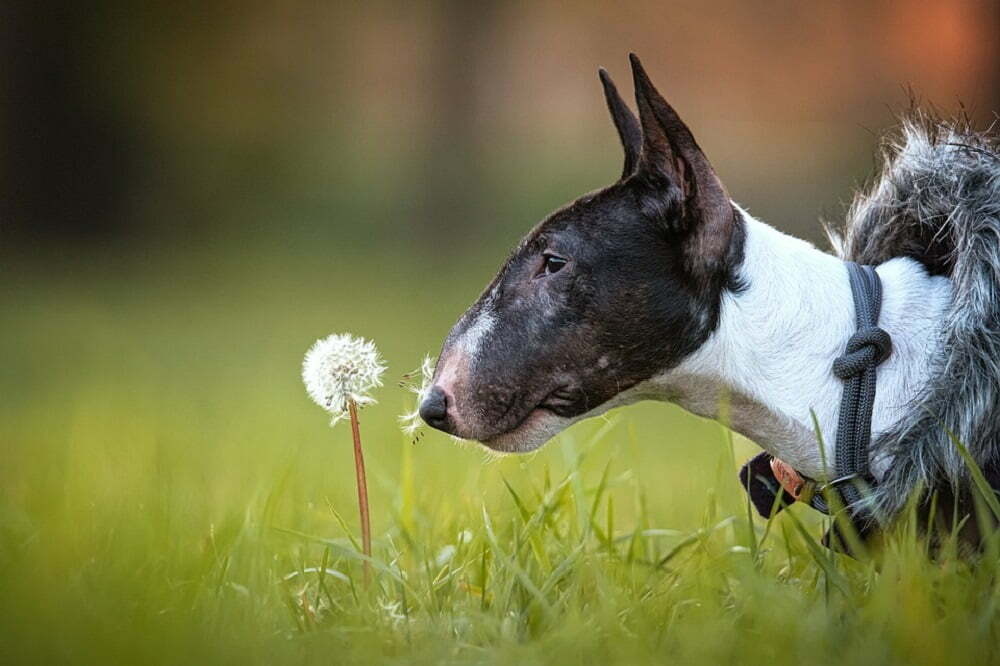The Bull Terrier is one of the most iconic, yet also most misunderstood dog breeds in the world.
Education is the key to dispelling myths and misconceptions and ensuring that you can make the best decisions in bringing home and caring for a specific dog breed.

Today, we’ll be exploring the origins, appearance, temperament, and trainability of the Bull Terrier. We’ve done extensive research and pooled together all the information you’ll need to work out if a Bull Terrier is the right choice of dog for you and your family.
Key Facts
Average Lifespan
Bull Terriers can live for anywhere between 10 and 14 years. This means that the average lifespan for a Bull Terrier is 12 years.
However, some Bull Terriers exceed this expected lifespan significantly. One Bull Terrier called Maximum Bodacious ended up living to the grand old age of 24!
Meanwhile, certain health conditions (which we’ll go into in more detail in our dedicated section on common health conditions of the breed) can decrease the lifespan of a Bull Terrier. Other factors such as diet and exercise can also significantly impact the dog’s lifespan.
Minimum Exercise (Per Day)
If you want your Bull Terrier to stay in good health (both physical and mental) for as long as possible, it’s crucial to make sure that your dog gets at least 1 hour of exercise every day.
Of course, you’ll need to take your Bull Terrier for walks, and this should make up a sizeable portion of your dog’s daily exercise. However, you also need to make time for more energetic play, which will benefit your Bull Terrier physically and keep them from getting bored and frustrated.
Coat Length
Bull Terriers have short, shiny, dense coats that come in a variety of different colors. Some Bull Terriers have coats of a single color (white or black, for example), while others sport coats with as many as 3 colors.
Minimum Cost (Per Month)
When bringing home a Bull Terrier, you should be prepared to spend between $39 and $52 on food alone. This would be the minimum monthly cost of keeping your Bull Terrier, meaning that it would be the only expense on a month that doesn’t include visits to the vet or the purchase of other essentials.
Appearance
Size
The Standard Bull Terrier is a medium-sized breed. However, you can also find Miniature Bull Terriers, which are essentially small versions of the breed. These Mini Bull Terriers, for anyone who might be curious, have a lineage that includes the Bulldog, Dalmatian, and English White Terrier.
Average Height
On average, the Standard Bull Terrier measures between 21 and 22 inches tall when measured at the shoulder.
Average Weight
It’s worth noting that there is quite a lot of variety when it comes to the average weight of the Bull Terrier. Some dogs are naturally a little smaller, while others are just naturally bigger. However, there is a natural weight range that you should aim to keep your dog within to ensure a long and healthy life.
For male Bull Terriers, the healthy weight range is between 55 and 65 pounds. For females, the weight range is about 10 pounds lower, at 45 to 55 pounds.
Temperament
Apartment Living
Bull Terriers can do well in an apartment living situation if they receive enough outdoor exercise daily.
However, you should still make sure that there’s enough space in your apartment for your Bull Terrier to be relatively active outside of scheduled exercise. Tiny, cramped, and cluttered apartments aren’t the best environments for Bull Terriers.
Good for Novice Owners?
In general, Bull Terriers aren’t recommended for novice dog owners. The reason for this is that they can be very stubborn and strong-willed, so they need an experienced owner to make sure that they complete their behavioral training properly.
Substandard training can lead to behavioral problems with your Bull Terrier, and since this breed is so physically strong, this can turn into a potentially dangerous situation.
Sensitivity Level
The Bull Terrier is a highly sensitive dog breed. It is very tuned in to changes in its surroundings and routine, and it will easily pick up on emotional cues. The Bull Terrier is the type of dog that reflects the emotional and behavioral state of its owner, and unlike some more easy-going breeds, it is very sensitive to punishment.
Tolerates Being Alone?
Bull Terriers are close-bonding animals that love to be around their owner(s) as much as possible. Because of this, a Bull Terrier is unlikely to adapt well to being left alone for very long.
Tolerates Cold Weather?
The Bull Terrier has a very short coat, so despite its muscular build, which allows it to shiver effectively in response to cold weather, it is still quite vulnerable to the cold.
Tolerates Hot Weather?
Bull Terriers tolerate hot weather quite well. If we had to rank this breed’s heat tolerance on a scale of 1 to 5, we’d say the Bull Terrier was a solid 4.
Thanks to their short coats, Bull Terriers won’t begin to overheat until the temperature gets more extreme. In this case, as with most other dogs, owners should take care to keep their Bull Terrier in shaded areas as much as possible, with access to plenty of water.
Affectionate With Family?
Bull Terriers may have a violent reputation, but when it comes to the breed’s interactions with their owners and families, the opposite is true.
The Bull Terrier bonds closely with its owners and displays playful, gentle, and loving behaviors with its family.
Kid-Friendly?
Bull Terriers are not the best breed to have around very small children. This is not because the breed is inherently dangerous, but because young children often lack the concept of boundaries when it comes to interacting with animals. Moreover, a Bull Terrier in play mode might fail to recognize its own strength.
If you have both a Bull Terrier and a young child, please keep all interactions closely supervised and do not allow any teasing or provoking behavior directed towards the dog.
Older children, however, make excellent playmates for Bull Terriers. Interactions should still be supervised, of course, but as long as the child is sensible and respectful, it’s unlikely that there would be an issue.
Dog Friendly?
Whether or not a Bull Terrier is friendly towards other dogs largely depends on the amount and quality of socialization it received at a young age.
An experienced owner who socializes their Bull Terrier properly as a puppy is likely to be successful in raising a calm, dog-friendly Bull Terrier.
However, if a Bull Terrier is not socialized with other dogs, it may become territorial and display aggressive behavior as a result.
Friendly Towards Strangers?
Because the Bull Terrier is naturally protective of its family, it may be suspicious of strangers.
However, as long as your Bull Terrier has been properly trained, socialized, and raised in a stable, calm, and loving environment, you shouldn’t worry about unwarranted aggression towards strangers.
Health and Grooming

Shedding
Bull Terriers, as a rule, don’t tend to shed very much. They are seasonal shedders, though, which means that you’ll notice an uptake in shedding during the Spring and Fall months.
However, when Bull Terriers do shed, their hairs can be annoying to remove from clothes and furniture. You may want to keep a designated lint brush for this purpose.
Drooling
Bull Terriers do not drool much compared to other dogs. However, drool production may be increased when the dog is panting or has just had a drink of water.
If you notice your Bull Terrier drooling a little, this isn’t a cause for concern. However, if the drooling becomes excessive, you may wish to seek professional advice as this isn’t typical of the breed.
Grooming
The Bull Terrier is a pretty low-maintenance breed when it comes to grooming. However, this doesn’t mean you can skip out on your grooming duties as an owner.
Bull Terriers should be brushed once a week with a curry brush. This will prevent a buildup of small, loose hairs in your dog’s coat. During this grooming session, it’s also wise to check your dog’s ears for any signs of injury or infection and check the length of their nails to see if they need trimming.
Where bathing is concerned, Bull Terriers are naturally quite clean, so this isn’t a process you’ll need to go through often unless your dog likes to roll around in the mud a lot. Once a month is a good schedule to stick to.
General Health
The general health of the Bull Terrier has been classified by experts as Category 2. This means that there is the potential for certain features of the breed, which have been exaggerated for aesthetic purposes, to turn into health issues.
Luckily, most of the potential issues can be screened for while the Bull Terrier is still a puppy, which means that any degenerative problems can be caught early.
Common Health Problems
One of the most common health issues that develop in Bull Terriers is deafness. While it’s not entirely clear why deafness is so common in Bull Terriers, it’s estimated that at least 18% of Bull Terriers are affected by hearing loss.
Bull Terriers are also frequently affected by a genetic disease called Lethal acrodermatitis. This is a very severe skin condition for which there is currently no cure. Usually, the condition progresses to a fatal level by the time the dog reaches the age of 2. It’s worth noting, however, that Lethal acrodermatitis only affects white Bull Terriers.
Both kidney issues and heart problems have been observed at an elevated rate in Bull Terriers, so frequent heart monitoring and urine tests are recommended for the breed.
In the less serious category of potential health conditions, many Bull Terriers are known to suffer from Atopy (a dermatological allergy affecting the ears and skin) and Luxating patellas, which is where a dog’s kneecaps slip momentarily out of place. The latter can be very painful, as can the former if it causes an ear infection.
Potential for Weight Gain
It’s important to monitor your Bull Terrier’s food consumption and exercise carefully to make sure that they don’t become obese.
Left to their own devices, Bull Terriers will eat a lot, which increases their potential for weight gain. Therefore, it’s important to always follow expert guidelines on how much and how often to feed your Bull Terrier.
Trainability
Easy to Train?
Bull Terriers are pretty headstrong, so training them isn’t easy. This is why we would only recommend a Bull Terrier to an experienced dog owner who knows the ropes when it comes to training.
With that being said, patience, consistency, and positive reinforcement will dramatically increase the likelihood of success in training a Bull Terrier.
Intelligence
Most of the time, dogs are ranked in terms of intelligence according to how well they respond to commands and perform tricks. However, where the Bull Terrier is concerned, this isn’t a fair method of assessing intelligence.
For one thing, Bull Terriers are often stubborn, which means that their reluctance to respond to commands may have less to do with intelligence and more to do with personality.
Moreover, Bull Terriers have high instinctive intelligence, which means they are excellent hunters.
Potential to Bite
The misconception that Bull Terriers are naturally aggressive or violent comes from the fact that they are physically extremely strong and have historically been employed in violent sports by humans.
However, in reality, a properly trained and socialized Bull Terrier will not bite randomly or unprovoked. In fact, contrary to popular belief, Bull Terriers were historically bred not to be aggressive towards the humans who needed to step in and break up dog fights.
When the Bull Terrier does bite, however, it can deliver a bite force of 269 PSI, which is a level of damage you definitely want to avoid.
Tendency to Bark or Howl
Bull Terriers are typically quiet dogs that don’t bark a lot unless there’s a good reason. Sometimes, however, they do howl to communicate with other dogs.
Some Bull Terriers have been observed to grumble, grunt, or snort. Sometimes, these can be confused for growling, but that’s not actually the case. Rather, Bull Terriers can sometimes have trouble drawing air through their uniquely shaped noses, which can produce off noises.
History

The origins of the Bull Terrier as we know it today can be traced back to the 19th century. In 1835 or thereabouts, the first Bull Terrier was bred into existence through a cross between the Bulldog and the English Terrier.
Sadly, the purpose for which the Bull Terrier was originally bred was fighting. Specifically, the breed was employed in bull-baiting arenas. Bull-baiting is a blood sport that involves exactly what you might expect from the name: putting a bull and another animal (in this case, and most cases, a dog) into an arena and watching the resulting struggle.
By the time the Bull Terrier came to be, bull-baiting was technically illegal. However, many underground bull-baiting rings were still in operation.
Eventually, the reputation of the Bull Terrier as a fighting dog combined with the decline of blood sports under animal cruelty legislation led the breed to be viewed as a status dog for wealthy owners.
Bull Terriers are primarily family companions today, although they often feature as show dogs because of their distinctive appearance.
Costs
If you buy your Bull Terrier from a breeder, you should be prepared to part ways with anywhere between $1,200 and $2000 for a healthy puppy.
However, if possible, please adopt your Bull Terrier from a shelter or rescue center, even if it means bringing home an older dog. When you choose to adopt rather than shop, you’ll not only be provided a much-needed home to an animal in need but there’s also a financial advantage. Most of the time, vaccinations will be covered by the adoption fee.
Food for a Bull Terrier can cost up to $52 a month, which comes to $624 every year.
Then there are trips to the vet and treatments to consider. As we mentioned previously, Bull Terriers are prone to a number of health conditions. Treating Patellar Luxation can cost anywhere between $300 and $3,000, depending on the severity.
Training can cost up to $1,225 for this breed, including crate and potty training lessons.
Overall, it’s estimated that owning a Bull Terrier can cost $4,590 in the first year and $1,635 in subsequent years.
Fun Facts
- During the 1860s, a man named James Hinks bred the Bull Terrier with the White Terrier (now extinct) and the Dalmation to create a completely white version of the breed with more elongated facial features. This breed was named the White Cavalier.
- In 1929, a Bull Terrier puppy called Patsy Ann became the official greeter of boats docking in Juneau.
